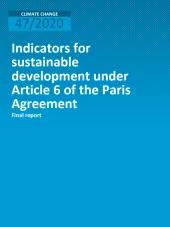This report assesses options for the effective implementation of sustainable development impact assessment, in the context of climate change mitigation mechanisms such as those of Article 6 of the Paris Agreement. To ensure that these mechanisms contribute to sustainable development in the host country, it is necessary to measure this effect. The results of the project show how and which indicators at project level can be used in a targeted manner for monitoring, reporting and verification (MRV). In this way, tools are made available to decision-makers and project developers in voluntary and mandatory markets to substantiate the sustainable effect of market mechanisms.
Main findings:
This report assesses options for the effective implementation of sustainable development impact assessment, in the context of climate change mitigation mechanisms such as those of Article 6 of the Paris Agreement. Existing carbon crediting programmes were analysed to draw insights on the best approaches for sustainable development impact assessment and the use of indicators.
The requirements of sustainable development assessment cannot be generalised,but rather the appropriate complexity, rigour and granularity should depend on the rationale of the programme with regards to the intended use of the assessment results and potential commodification of outcomes.More complex and rigorous approaches to sustainable development impact assessment may help to improve understanding of the project impact, but may also result in additional transaction costs that could be unnecessary for some purposes.
From the analysis of existing project-level indicators for sustainable development impact assessment, we derive lessons and pragmatic solutions for the effective use of indicators and measures to decrease complexity and associated transaction costs while safeguarding a reliable assessment of the sustainable impact of activities. This includes a discussion on the provision of flexibility in MRV approaches, as well as the identification of potential links to internationally accepted benchmarks and accessible data sources, amongst other solutions.We set out a criteria based checklist for the formulation of objective and comparable indicators and assess whether existing indicators can be optimized with regards to their specificity and the type of expression in their formulation.
Lastly, we assess approaches for safeguarding against potential negative impacts,finding that stakeholder consultation and grievance mechanisms are essential to identify and respond to unforeseen negative impacts, and that pre-defined indicators are useful yet not alone sufficient towards that objective.






